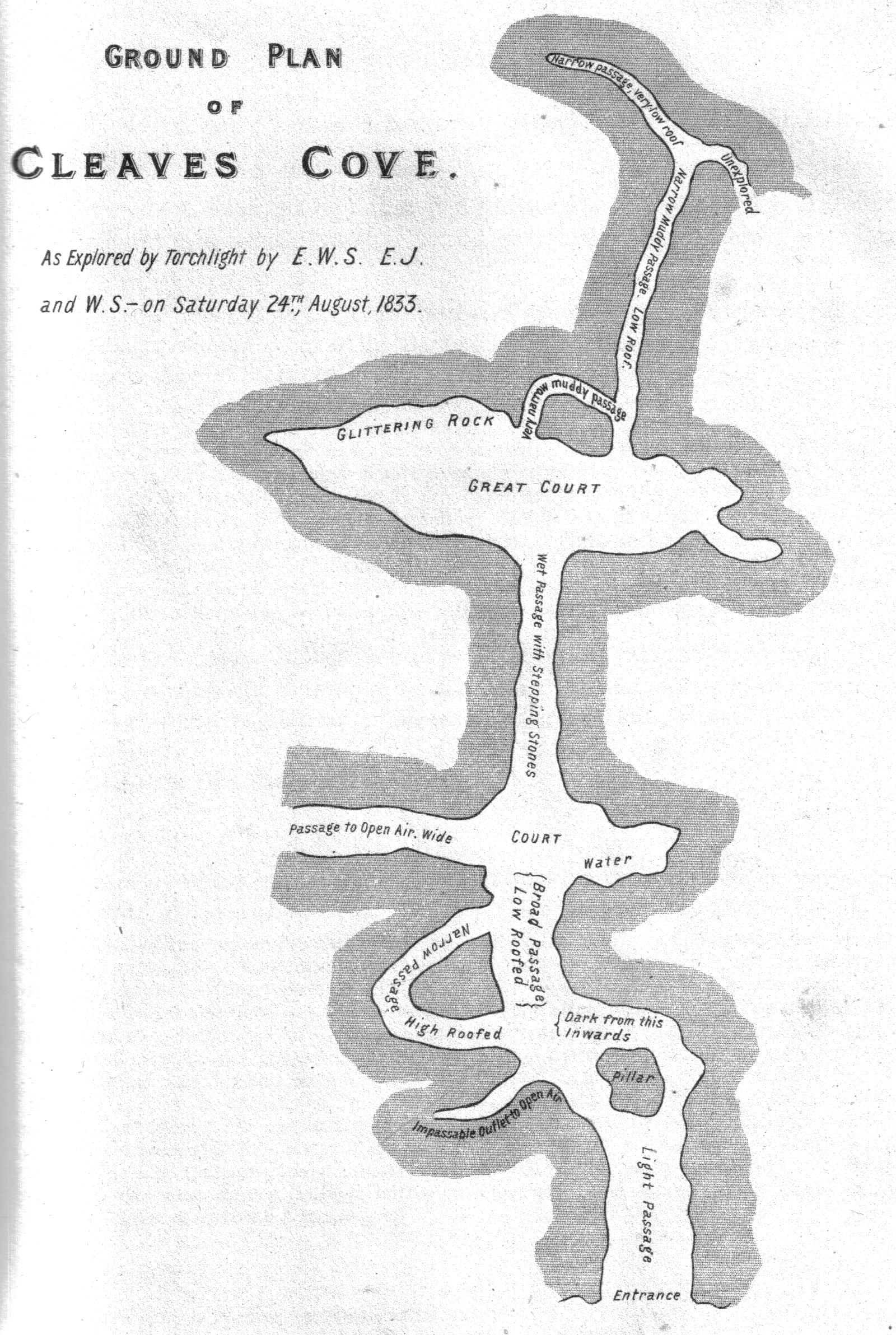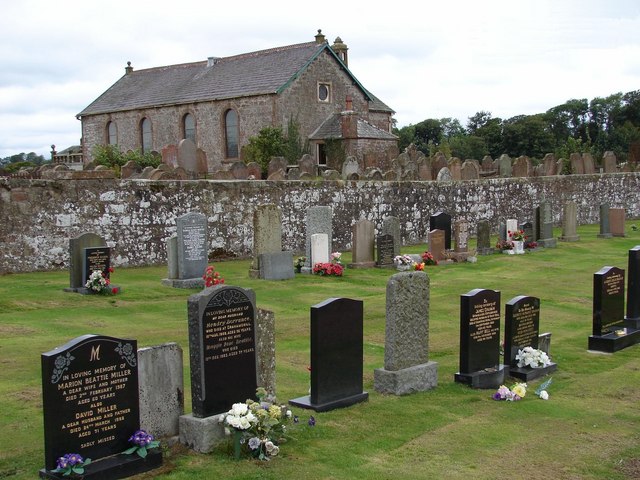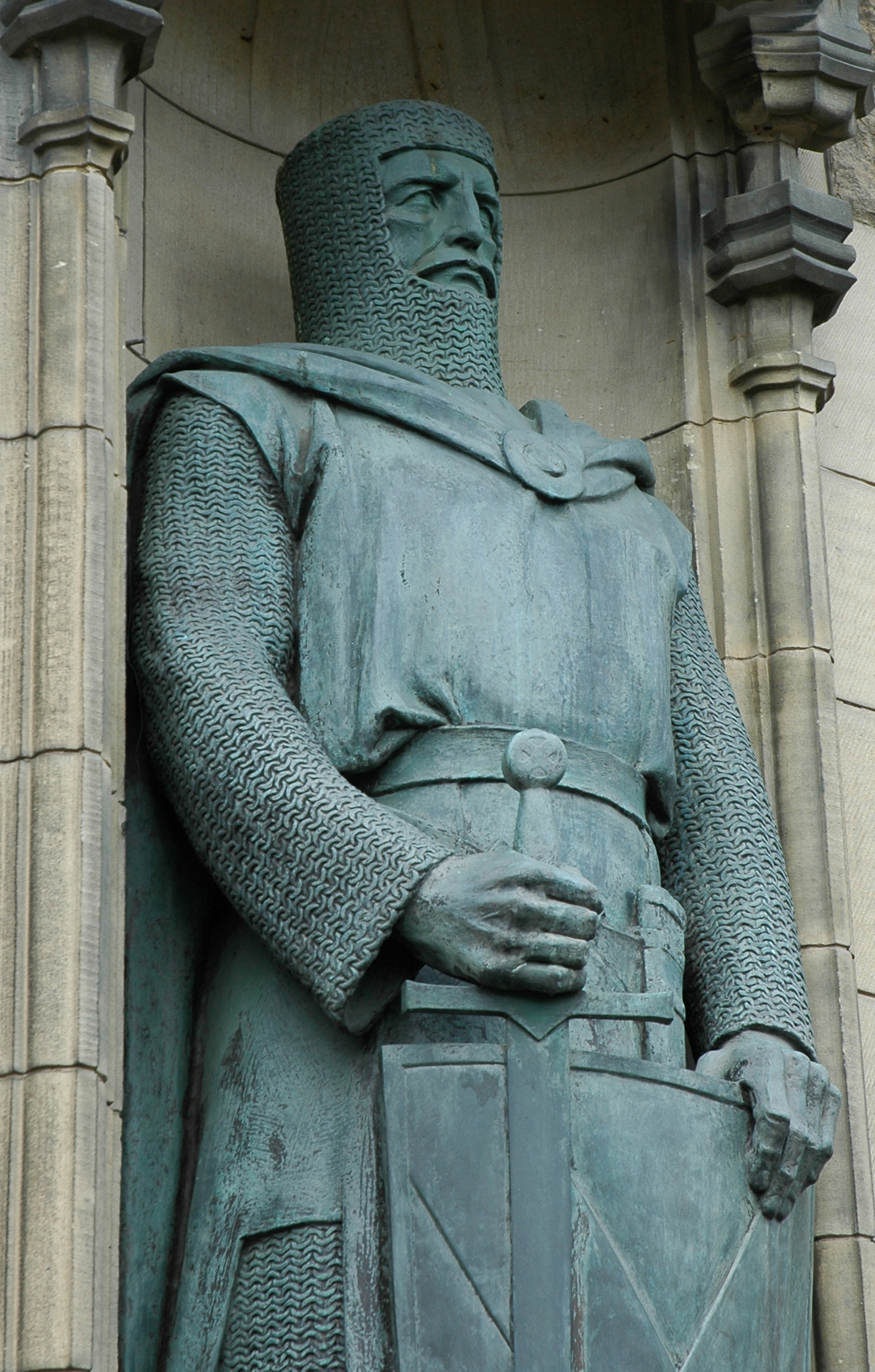|
Wallace's Cave, Auchinleck
Wallace's Cave in the Lugar Gorge at Auchinleck in the Parish of Auchinleck is an 18th-century grotto contemporary with Dr Johnson's Summerhouse, also located on the Auchinleck Estate. It shows superior workmanship in its construction, possibly being the enlargement of a pre-existing cave. The cave or grotto lies downstream of the confluence of the Dippol Burn with the River Lugar and is reached via a once well formed path, however access is now hazardous due to the condition of the cliff edge path and the vertical drop into the River Lugar. Cave and access The cave is a Category B Listed Building that is reached via a narrow path and some rock cut steps that follow the River Lugar gorge. Lying within a side gorge cut by a small burn the final approach requires the crossing of the burn. The masons chisel marks are very clear on the walls and their work created a chamber with a floor area of approximately 14 square feet with prominent rib vaults that rise from the four corners ... [...More Info...] [...Related Items...] OR: [Wikipedia] [Google] [Baidu] |
Auchinleck
Auchinleck ( ; sco, Affleck ; gd, Achadh nan Leac) is a village southeast of , and northwest of in , . Surrounding the village is Auchinleck Estate, centred on |
New Lanark
New Lanark is a village on the River Clyde, approximately 1.4 miles (2.2 kilometres) from Lanark, in Lanarkshire, and some southeast of Glasgow, Scotland. It was founded in 1785 and opened in 1786 by David Dale, who built cotton mills and housing for the mill workers. Dale built the mills there in a brief partnership with the English inventor and entrepreneur Richard Arkwright to take advantage of the water power provided by the only waterfalls on the River Clyde. Under the ownership of a partnership that included Dale's son-in-law, Robert Owen, a Welsh utopian socialist and philanthropist, New Lanark became a successful business and an early example of a planned settlement and so an important milestone in the historical development of urban planning. The New Lanark mills operated until 1968. After a period of decline, the New Lanark Conservation Trust (NLCT) was founded in 1974 (now known as thNew Lanark Trust(NLT)) to prevent demolition of the village. By 2006 most of the bu ... [...More Info...] [...Related Items...] OR: [Wikipedia] [Google] [Baidu] |
Peden's Cave (Auchinbay)
Peden's Cave is at least partly artificial and is set into a craggy outcrop of red sandstone rocks overlooking the River Lugar just below the farm of Auchinbay in East Ayrshire, Scotland, close to the town of Ochiltree. Traditionally it is said that this cave was used as a hiding place for Covenanters, including the famous Covenanter minister Alexander Peden in the 17th century, mainly during the so-called 'Killing Times' of the 1680s. Cave and access Peden's Cave is located near the top of a much eroded red sandstone cliff, the cave floor being around above the River Lugar on the south-western side of this water course, just off the old road that ran from Stair past Auchinbay Farm and over the old Slatehole Ford, later replaced by the now ruined Slatehole Bridge and its associated lodge, running into the Auchinleck Estate. The cave is well camouflaged from directly above. The well known Wallace's Cave' is located at the junction of the River Lugar and the Dippol Burn, a shor ... [...More Info...] [...Related Items...] OR: [Wikipedia] [Google] [Baidu] |
The Holy Cave, Hunterston
The Holy Cave at Hunterston in the Parish of West Kilbride is associated with Saint Mungo, also known as St Kentigern and is often referred to as the Hawking Craig Cave however two caves exists in the Hawking Craig Wood and 'Three Sisters' area of the cliffs, the other being Smith's Cave, better described as a rock shelter lying a short distance to the south. The main cave has been excavated and the finds indicate three periods of occupation over many centuries. Cave and access The cave stands about 300 yards from the northern end of the red sandstone cliffs and was formed by wave action working at a weak point, a fissure, at the base of red sandstone cliffs that run from the Brigurd Point to Portencross however it now stands about above the level of the old raised beach that runs down to the sea. The cave is not very large (high, wide, and about long) and is now best accessed by entering the Hawking Craig Wood near the 'Three Sisters' cliffs and carefully walking along the base ... [...More Info...] [...Related Items...] OR: [Wikipedia] [Google] [Baidu] |
Dunton Cove
Dunton Cove or the Covenanters' Cave is an artificial cave in a craggy outcrop of rocks overlooking the Craufurdland Water just below the confluence of the Dunton Water and the Calf Fauld Water in East Ayrshire, Scotland, close to the village of Waterside. Traditionally it was used as a hiding place for Covenanters in the 17th century during the so-called 'Killing Times' of the 1680s. Cave and access The Dunton Cove is located in a stone cliff above the Craufurdland Water on the east side of the water course, just off the private road leading from Airtnoch Farm through the forestry plantations to Craigendunton and the old reservoir. The cave is only large enough for a few people and the regular lines of the rectangular opening add emphasis to its artificial origin or creation from a pre-existing cavity. Several hand and foot holds have been cut into the rock face however access is difficult. Internally the cave has no special features such as a shelf for sitting and its the ... [...More Info...] [...Related Items...] OR: [Wikipedia] [Google] [Baidu] |
Cleeves Cove
Cleeves Cove or Blair Cove is a solutional cave system on the Dusk Water in North Ayrshire, Scotland, close to the town of Dalry. Cave system The Cleeves, or Cleaves Cove (Scots) cave system is situated in the lower beds of Carboniferous limestone. It has a total passage length of around . The caves are now well above the level of the Dusk Water and lie close to Cleeves Farm and Blair Mill on the Blair Estate. Many of the stalactites and stalagmites have been damaged by visitors. The cave has three practical entrances facing onto the Dusk Water. A number of older books refer to ''the romantic sylvan dell of Auchenskeigh,'' now Auchenskeith, derived from ''Achadh-na-sgitheach'' - the field of thorns.Dobie, James D. (ed Dobie, J.S.) (1876). ''Cunninghame, Topographized by Timothy Pont'' 1604–1608, with continuations and illustrative notices. Pub. Glasgow : John Tweed. p. 49. The calcareous incrustations in these caves were compared with Gothic fretwork. A number of old limest ... [...More Info...] [...Related Items...] OR: [Wikipedia] [Google] [Baidu] |
Bickering Bush
The Bickering bush (NS41863635) thorn grew near Caprington on the lands of Monksholm or Maxholm, Riccarton, East Ayrshire, Scotland. The old farm house at Maxholm sat in hollow on the old Caprington Castle estate and to the north and west its fields bordered the River Irvine. The thorn was located, as recorded on the OS map, near to the confluence of the Kilmarnock Water and the River Irvine, downstream of the Simon's Burn's (aka Maxholm Burn) confluence on the south bank of the river. Legend has it that in around the year 1292 Sir William Wallace was involved in an incident in which he killed two or three out of five English soldiers who were attempting to take his catch of fish and the 'Bickering Bush' thorn marked the spot. History One version of the story records that: "''Wallace one day when fishing in the Irvine Water fell in with a party of English Soldiers 5 in number, who demanded his fish, he offered them part, but less than the whole wold not Satisfy them, unwil ... [...More Info...] [...Related Items...] OR: [Wikipedia] [Google] [Baidu] |
Glasgow
Glasgow ( ; sco, Glesca or ; gd, Glaschu ) is the most populous city in Scotland and the fourth-most populous city in the United Kingdom, as well as being the 27th largest city by population in Europe. In 2020, it had an estimated population of 635,640. Straddling the border between historic Lanarkshire and Renfrewshire, the city now forms the Glasgow City Council area, one of the 32 council areas of Scotland, and is governed by Glasgow City Council. It is situated on the River Clyde in the country's West Central Lowlands. Glasgow has the largest economy in Scotland and the third-highest GDP per capita of any city in the UK. Glasgow's major cultural institutions – the Burrell Collection, Kelvingrove Art Gallery and Museum, the Royal Conservatoire of Scotland, the Royal Scottish National Orchestra, Scottish Ballet and Scottish Opera – enjoy international reputations. The city was the European Capital of Culture in 1990 and is notable for its architectur ... [...More Info...] [...Related Items...] OR: [Wikipedia] [Google] [Baidu] |
Sir William Wallace
Sir William Wallace ( gd, Uilleam Uallas, ; Norman French: ; 23 August 1305) was a Scottish knight who became one of the main leaders during the First War of Scottish Independence. Along with Andrew Moray, Wallace defeated an English army at the Battle of Stirling Bridge in September 1297. He was appointed Guardian of Scotland and served until his defeat at the Battle of Falkirk in July 1298. In August 1305, Wallace was captured in Robroyston, near Glasgow, and handed over to King Edward I of England, who had him hanged, drawn and quartered for high treason and crimes against English civilians. Since his death, Wallace has obtained an iconic status far beyond his homeland. He is the protagonist of Blind Harry's 15th-century epic poem '' The Wallace'' and the subject of literary works by Jane Porter and Sir Walter Scott, and of the Academy Award-winning film '' Braveheart''. Background William Wallace was a member of the lesser nobility, but little is definitely known of hi ... [...More Info...] [...Related Items...] OR: [Wikipedia] [Google] [Baidu] |
Kirkpatrick Fleming
Kirkpatrick-Fleming (Scottish Gaelic: Cill Phàdraig) is a village and civil parish in Dumfries and Galloway, south-west Scotland. It is located between the Kirtle Water and the A74(M) motorway, the Solway Firth, and the Cumbrian hills are visible from the village. Kirkpatrick-Fleming is east of Annan, east of Dumfries, north-west of Gretna and north-west of Carlisle. Etymology The name is derived from the parish church, dedicated to St Patrick, and the Fleming family, the local landowners who resided at Redhall. The medieval parish church was given to Gisborough Priory in Cleveland by Robert de Brus, Lord of Annandale, around 1170, though this connection lapsed after 1330. The present church dates to the 18th century and is protected as a category B listed building. Railways The village was served by Kirkpatrick railway station on the old Caledonian Railway main line from 1847 to 1960. Today, the line is part of the West Coast Main Line. Bruce's Cave Bruce's Cav ... [...More Info...] [...Related Items...] OR: [Wikipedia] [Google] [Baidu] |
Deer Cave, Rock Cut Chamber, Auchinleck Estate
Deer or true deer are hoofed ruminant mammals forming the family Cervidae. The two main groups of deer are the Cervinae, including the muntjac, the elk (wapiti), the red deer, and the fallow deer; and the Capreolinae, including the reindeer (caribou), white-tailed deer, the roe deer, and the moose. Male deer of all species (except the water deer), as well as female reindeer, grow and shed new antlers each year. In this they differ from permanently horned antelope, which are part of a different family (Bovidae) within the same order of even-toed ungulates (Artiodactyla). The musk deer (Moschidae) of Asia and chevrotains (Tragulidae) of tropical African and Asian forests are separate families that are also in the ruminant clade Ruminantia; they are not especially closely related to Cervidae. Deer appear in art from Paleolithic cave paintings onwards, and they have played a role in mythology, religion, and literature throughout history, as well as in heraldry, such as red de ... [...More Info...] [...Related Items...] OR: [Wikipedia] [Google] [Baidu] |
William Wallace
Sir William Wallace ( gd, Uilleam Uallas, ; Norman French: ; 23 August 1305) was a Scottish knight who became one of the main leaders during the First War of Scottish Independence. Along with Andrew Moray, Wallace defeated an English army at the Battle of Stirling Bridge in September 1297. He was appointed Guardian of Scotland and served until his defeat at the Battle of Falkirk in July 1298. In August 1305, Wallace was captured in Robroyston, near Glasgow, and handed over to King Edward I of England, who had him hanged, drawn and quartered for high treason and crimes against English civilians. Since his death, Wallace has obtained an iconic status far beyond his homeland. He is the protagonist of Blind Harry's 15th-century epic poem '' The Wallace'' and the subject of literary works by Jane Porter and Sir Walter Scott, and of the Academy Award-winning film '' Braveheart''. Background William Wallace was a member of the lesser nobility, but little is definitely known of ... [...More Info...] [...Related Items...] OR: [Wikipedia] [Google] [Baidu] |
.jpg)



.jpg)
